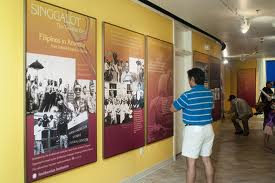Smithsonian’s Filipinos in America exhibit comes to Honolulu
HONOLULU— The Smithsonian Institution’s “Singgalot: The Ties That Bind” will be on exhibit from October 1 to 31 at the Aiea Public Library during regular open hours.
The “Singgalot” exhibition explores the experience of Filipinos as colonial subjects and examines their struggles to acquire full citizenship as immigrants in the United States throughout the previous century.
Originally displayed at the Smithsonian Institution and the Bishop Museum in 2006, “Singgalot” was created by the Smithsonian Asian Pacific American Program with the University of Hawaii Department of Ethnic Studies to commemorate 100 years of the Filipino American experience in the United States.
Dean Alegado, formerly of the University of Hawaii at Manoa, and Franklin Odo of the Smithsonian Institution co-curated the exhibition.
The exhibit is presented by the Filipino American Historical Society of Hawaii, in partnership with the Filipino Community Center, Inc., the University of Hawaii Office of Multicultural Student Services and the Aiea Public Library.
Using rare photographs and illustrations from the National Archives, the Library of Congress and personal collections, the exhibition traces Filipino presence in North America from the first transoceanic trade missions between Manila and Acapulco in the mid-16th century to the 19th century.
During this period Filipinos settled in the bayous of Louisiana and came as American “nationals” after the United States acquired the Philippines following the Spanish-American War in 1898. Filipinos would later fill the labor needs of Hawaii’s plantations, California’s farms and Alaska’s salmon canneries.
The exhibition also highlights Filipino public service in the U.S. military, achievements in literature, arts and sports, and in the health care industry. The past four decades have witnessed tremendous growth of the Filipino American community, and the current group of immigrants who began arriving after 1965 has revitalized Filipino ethnic identity and culture in the United States.
The Smithsonian Asian Pacific American Program goals tries to reflect experiences of Asian Pacific Americans in all aspects of Smithsonian work; to improve the public’s appreciation of the role of Asian Pacific Americans in the history of the nation; and to empower Asian Pacific American communities by increasing their sense of inclusion in the national culture.
Like us on Facebook

